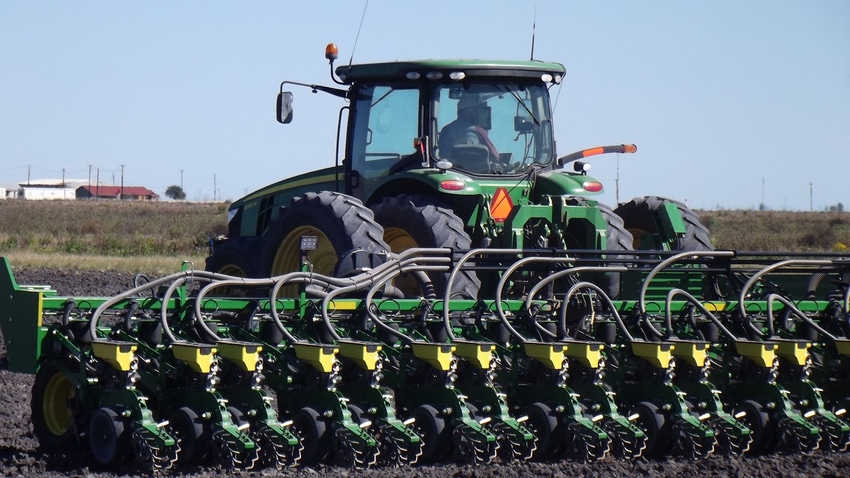March 13, 2017

From the Lower Rio Grande Valley and across the Texas Winter Garden, the Coastal Bend and up the coast through Southeast Texas to the Louisiana line, planting traditionally starts early each year, usually ahead of all other areas in the 48 lower states.
This year, things have been a little different, an early start with a twist, and now, with spring bearing down on farmers, especially in South Texas, the rains have arrived and cooler temps are slowing down cotton planting.
Over the last seven days most of coastal Texas, from the tip of South Texas northeast to the Louisiana line, rainfall amounts have ranged from 2 to 5 inches with isolated reports of 5-plus inches in a few areas. Reports in Nueces, Sinton, Live Oak, Aransas, San Patricio, Refugio and Victoria counties include standing water in some fields where corn was planted early. While it remains too early to determine if current wet conditions or additional rain forecast this week will hamper or destroy corn planting efforts to date, Extension agents and crop consultants up and down the coast are taking a wait-and-see stand on the issue, especially in areas that were hardest hit.
CLOUDY AND COOL
Complicating their analyses are cool, cloudy conditions not conducive to a substantial drying trend over the course of this week, according to National Weather Service forecasters in Corpus Christi. Less than a week after South Texas farmers began planting cotton, weather conditions abruptly changed as Gulf moisture streamed on shore for several days bringing moderate rains, followed by heavier rains over the weekend as that weather pattern was joined by a late season cool front from the northwest. Those conditions were further complicated by a low pressure system out of Mexico.
Reports from the Rio Grande Valley indicate that while heavy rains have fallen across many areas of the border region disrupting cotton planting in progress, rainfall totals so far do not indicate serious damage. Extension and IPM reports over the weekend indicate that with a few days of drier conditions, fields should be dry enough to resume planting, though planting is slightly delayed compared to historical average planting dates.
In the Coastal Bend, cotton planting is running behind historical dates, and heavy rains late last week continue to threaten this week and will slow cotton planting even more. Newly emerged corn in some fields are covered or partially covered by standing water, making survival uncertain. Similar rains occurred in the Upper Coast region, where IPM officials warn corn producers to begin scouting regularly for pest problems as a result of recent rains and warmer than average winter temperatures.
According to Upper Coast IPM agent Kate Harrell, as conditions dry in the days ahead and farmers get back to planting cotton and prepare to plant grain sorghum and soybeans, they shouldn't forget insect and weed management, especially after the rains.
She said much of the insect control on corn in South Texas depends on Bt corn hybrids treated with insecticides for control of early season insect pests.
SCOUTING RECOMMENDED
"However, it is still a good practice to visit these fields on a weekly basis to check for potential insect pests," she warned.
In addition to concerns of over-wintering sugarcane aphids expected to threaten sorghum again this year, chinch bugs can damage seedling corn until it reaches a height of 12 inches. Insecticide application for chinch bugs is rarely necessary if insecticidal seed treatments are used.
Chinch bug nymphs are pale yellow when hatched but soon become red except for the first two abdominal segments that remain pale. Subsequent instars become darker red but retain a pale-yellow band across the front part of the abdomen. The last nymphal instar is black and gray with a conspicuous white spot on the back between the wing pads. The 4.2 millimeter adult chinch bug is black, with reddish-yellow legs, and conspicuous white forewings, each of which has a black triangular spot at the middle of the outer margin.
Chinch bugs overwinter as adults in bunch grass. In spring, they migrate from overwintering sites to small grains where they lay eggs. Insecticide should be applied when two or more adult chinch bugs are found on 20 percent of the seedlings less than 6 inches high. On taller plants, apply insecticides when immature and adult bugs are found on 75 percent of the plants. For the application to be successful, farmers should use high water volume (30 GPA) and multiple nozzles per row, directed at the plants.
Extension agents across Coastal Texas and the Winter Garden region south and west of San Antonio say weeds and pests are of equal concern with rains and warmer weather expected in the weeks ahead. Now, many fields have high numbers of newly emerged seedling grass and broadleaf weeds. Controlling these weeds before they reach a height of 4 to 6 inches is important as larger weeds are much more difficult to control.
While concern for wet conditions that will keep many South Texas farmers out of their fields over the next several days and possibly until after another cool front passes through the region this coming weekend, producers remain optimistic that planting will progress and say while heavy rains have slowed planting operations, the moisture benefit will help emerging crops in the weeks ahead.
You May Also Like




